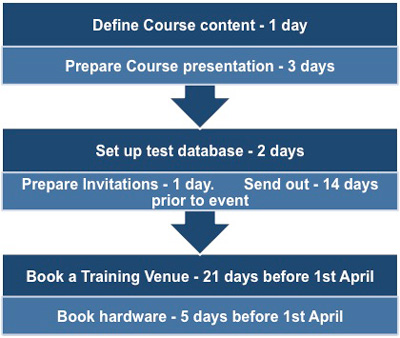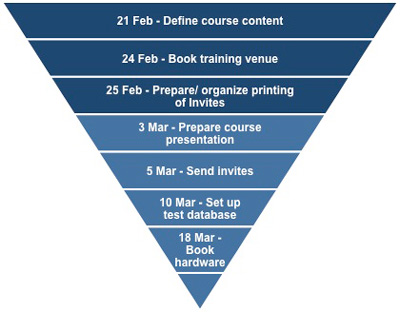Time Management - Using a Reverse Schedule
A Reverse Schedule is a way of setting milestones and a start date by working backwards from the required task's completion date. Even though it is a relatively straightforward process to perform, many people do not allocate sufficient time to allow the planning benefits of creating a Reverse Schedule to be realized.
By allocating adequate time at the planning stage you can avoid the stresses and strains often experienced in some projects through having to react to unforeseen circumstances.
Suppose, for example, that you are asked to organize a training workshop for a new piece of software. Today is Thursday, February 20, and the new software is due to go live on April 1.
You decide that the workshop will run on Tuesday, March 25.
This allows you time to reschedule if it has to be cancelled at the last minute.
Also, in the event of the workshop needing to be re-run, it allows you time to train those off ill or on vacation on the date.
This is the perfect time for the workshop as all of the skills that the trainees will have learnt during the training will still be fresh in their minds when the software goes live.
Once you know what task you will need to perform to organize your workshop, all you will then need to do is to allocate how many days you think each activity requires.
 |
As you can see, some of the tasks are described in terms of the man-days required and others in terms of how far in advance of the workshop they need to be completed.
Using this information, you can then work backwards, setting the start and end dates needed to achieve them.
As part of your scheduling, you will need to take into account the fact that some tasks are dependent on others. You also need to consider that you cannot work on more than one task at the same time without affecting the total time required.
Finally, you will need to adjust your schedule to take into account weekends, when much of the work cannot be done, making your lead time longer. As part of this reverse scheduling you will also highlight any activities where you are dependent on another colleague or external supplier. This will enable you to build in the appropriate contingency you will need when relying on third parties.
 |
The resulting schedule is useful in that it can prevent you from either panicking and trying to do everything at once, or procrastinating and leaving yourself insufficient time to complete some vital sub-task.
You may also be interested in:
Time Management Productivity Tools | Urgency/Importance Grid | ABC Analysis | Pareto Analysis | Closed To Do List | Calendar Tools | To Do List Tools | Launcher and HotKey Tools | Monitoring Tools | Productivity Tools.



